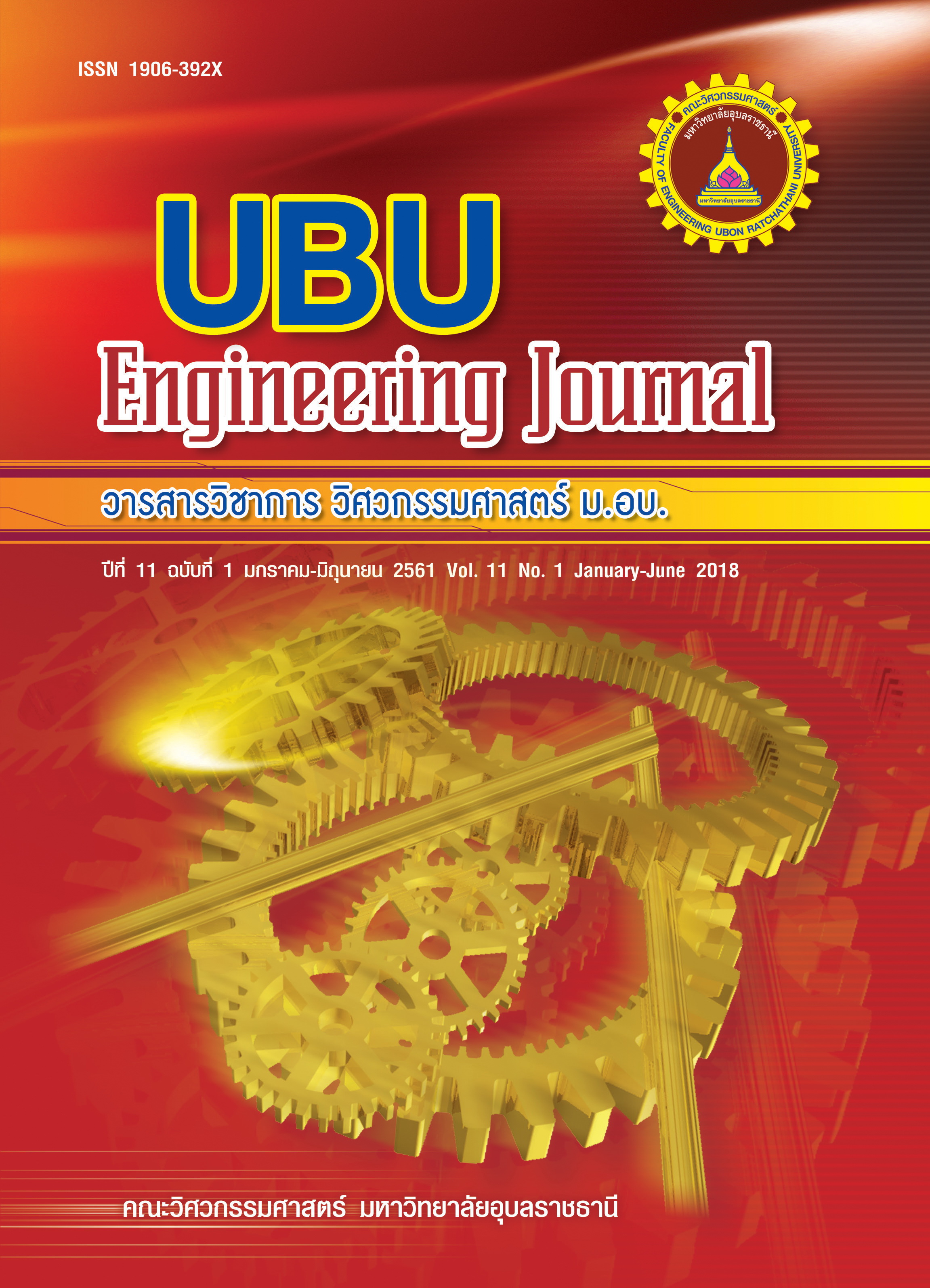สำหรับแผ่นการศึกษาค่าพารามิเตอร์ที่เหมาะสมอัดเศษวัสดุธรรมชาติ
Main Article Content
Abstract
This research aims to optimize the parameters for the natural waste material board forming. Three types of the natural waste materials have been used in this work including corn husk, water hyacinth and rice straw. The strengthen materials of each the natural waste material are cassava flour, saw dust and rice husk for corn husk, water hyacinth and rice straw. Two parameters were used in this study including mixture ratio and compressive force which were categorized as independent variable. From preliminary experimental results, the obtained fiber boards are good forming with no crack after dried at 0−30 weight percentage of the strengthen materials. From statistical analysis, the compressive force and the mixture ratio effect on the compressive and bending strength properties of the received boards. From the results, the corn husk board has the highest compressive strength with 30 ton of forming compressive force at 92:8 mixture ratio of the corn husk and the cassava flour. The predicted compressive strength value from regression analysis is 1,204.77 newton per square millimeter. The water hyacinth board gave the highest bending strength with the suitable forming compressive force at 30 ton and the mixture ratio of the water hyacinth and the rice husk at 92:8. The regressive equation analysis presents the highest predicted bending strength property value at 218.03 newton per square millimeter. Therefore, the produced boards from corn husk and water hyacinth are more appropriate than the rice straw board in compressive and bending application. Hence, in utility, the board type determination should consider the environment and force which react on it. Finally, this project can be a guideline on the natural material waste board forming and can be used as the data base for development further in the future.
Article Details
References
[2] Juliana AH, Paridah MT, Anwar UMK. Properties of Three-Layer Particleboards Made from Kenaf (Hibiscus Cannabinus L.) and Rubber Wood (Hevea Brasiliensis). Material and Design. 2012; 40: 59−63.
[3] Wang D, Sun XS. Low Density Particleboard from Wheat Straw and Corn Pith. Industrial Crops and Products. 2002; 15: 43−50.
[4] Polat S, Uslu M, Ahmet A, Muharrem C. The Effects of the Addition of Corn Husk Fiber, Kaolin and Beeswax on Cross-Linked Corn Starch Foam. Journal of Food Engineering. 2013; 116: 267−276.
[5] Buyuksari U, Ayrilmis N, Avci E, Koc E. Evaluation of the Physical, Mechanical Properties and Formaldehyde Emission of Particleboard Manufactured from Waste Stone Pine (Pinus Pinea L.) Cones. Bioresource Technology. 201; 101: 255−259.
[6] Theng D, Arbat G, Delgado-Aguilar M, Vilaseca F, Bunthan N, Mutjé P. All-Lignocellulose Fiberboard from Corn Biomass and Cellulose Nano-fibers. Industrial Crops and Products. 2015; 76: 166−173.
[7] Kwon HJ, et al. Tensile Properties of kenaf fiber and Corn Husk Flour Reinforced Poly (Lactic Acid) Hybrid Bio-Composites: Role of Aspect Ratio of Natural Fibers. Composites: Part B. 2014; 56: 232−237
[8] Wu J, Zhang X, Wan J, Ma F, Tang Y, Zhang X. Production of Fiberboard Using Corn Stalk Pretreated with White-Rot Fungus Trametes Hirsute by Hot Pressing Without Adhesive. Bioresource Technology. 2011; 102: 11258−11261.
[9] Silva JC, et al. Extraction, Addition and Characterization of Hemicelluloses from Corn Cobs to Development of Paper Properties. Procedia Materials Science. 2015; 8: 793−801
[10] Saba N, Paridah MT, Jawaid M. Mechanical Properties of Kenaf Fiber Reinforced Polymer Composite: A Review. Contruction and Building Materials. 2015; 76: 87−96.
[11] Tabarsa T, Ashori A, Gholamzadeh M. Evaluation of Surface Roughness and Mechanical Properties of Particleboard Panels Made from Bagasse. Composites: Part B. 2011; 42: 1330−1335.
[12] Yalinkilicy MK, et al. Biological, Physical and Mechanical Properties of Particleboard Manufactured from Waste Tea Leaves. International Biodeterioration & Biodegradation. 1998; 41(1): 75−84.
[13] Nourbakhsh AAA. Effect of Press Cycle Time and Resin Content on Physical and Mechanical Properties of Particleboard Panels Made from the Underutilized Low-Quality Raw Materials. Industrial Crops and Products. 2008; 28(2): 225−230.
[14] วิลาวัลย์ เณรมณี. การศึกษาอัตราส่วนผสมแป้งข้าวเหนียว และกาวลาเท็กซ์ เพื่อนำมาใช้ปั้นดอกไม้ประจำชาติ. ใน: การประชุมวิชาการระดับชาติและนานาชาติราชภัฏเพชรบุรีวิจัยศิลปวัฒนธรรม ครั้งที่ 3; 2559.
[15] Saelee S, Sikkha S. The Development of Insulating Ceiling Boards and Walls from Plants in Thailand. Art and Architecture Journal Naresuan University. 2012; 3: 15−24.

